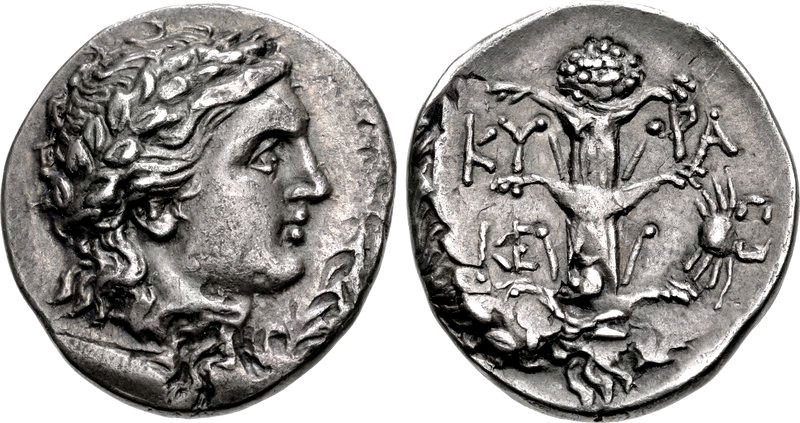Silphium – Remarkable Ancient Herb That Mysteriously Vanished
Ellen Lloyd - AncientPages.com - Once, a long time ago, there was a very precious herb in the ancient city of Cyrene, a Greek city on the North African coast near present-day Shahhat, a town located in northeastern Libya.
According to one legend, Silphium was first discovered after a “black” rain swept across the east coast of Libya over two and a half millennia ago. The herb spread its broad roots ever further from then onwards, growing luxuriantly on lush hillsides and forest meadows.
Ancient ruins of Cyrene. Credit: Wikimedia Commons - CC BY-SA 3.0
In time, ancient people discovered that the herb known as silphium was amazing in several ways. Silphium was so delicious and useful that the plant became very valuable.
Ancient cultures used silphium for medical applications, and the plant could help with several health problems.
According to Roman author Pliny, the Elder repeated fumigations with the root could be used to treat bites of feral dogs as well as problems related to growths of the anus.
Silphium had a wonderful smell. The perfume was coaxed from its delicate blooms while its sap was dried and grated liberally over dishes from brains to braised flamingo. Known as “laser,” the condiment was fundamental to Roman haute cuisine as eating your food horizontally in a toga.
Silphium was so fundamental to Cyrene's economy. The locals stamped its image on their money. Image credit: Classical Numismatic Group, Inc - CC BY-SA 3.0
Ancient people placed it in the bedroom where its juice was drunk as an aphrodisiac or applied “to purge the uterus.”
Some scholars have suggested the herb was the first genuinely effective birth control. The seeds of the herb are heart-shaped, and some think this could be why we associate the symbol with romance to this day.
Ancient Romans were so fond of Silphium that they referenced their darling herb in poems and songs. The herb was also mentioned in great works of literature.
For centuries, local kings held a monopoly on the plant, which made the city of Cyrene, at modern Shahhat, Libya, the richest in Africa. Before they gave it away to the Romans, the Greek inhabitants even put it on their money. Julius Caesar even went to store a cache (1,500lbs or 680kg) in the official treasury.
There are many reasons why Silphium was worth its weight in gold.
Sadly, Silphium has vanished. Not only from the region but our planet altogether.
Pliny The Elder wrote that within his lifetime, only a single stalk was discovered. It was plucked and sent to the emperor Nero as a curiosity sometime around 54-68 AD.
Silphium is thought to have been a close relative of asafoetida. Image credit: Valery Fassiaux - Public Domain
Why Silphium vanished is unknown. Perhaps the plant was over-harvested and overgrazed. Its own biology may have also undermined it.
Interestingly, scientists discovered that asafoetida silphium might have belonged to a group of fennel-like plants, the Ferula.
These plants are related to carrots and grow wild as weeds across North Africa and the Mediterranean.
Incredibly, two of these plants – giant Tangier fennel and giant fennel – still exist in Libya today. One of these may be Silphium.
Maybe it’s still possible to re-discover the lost ancient plant Silphium.
Written by Ellen Lloyd – AncientPages.com
Copyright © AncientPages.com All rights reserved. This material may not be published, broadcast, rewritten or redistributed in whole or part without the express written permission of AncientPages.com
More From Ancient Pages
-
 What Was The Medieval Shame Flute?
Ancient History Facts | Jan 27, 2020
What Was The Medieval Shame Flute?
Ancient History Facts | Jan 27, 2020 -
 A Scientist’s Powerful Dream Revealed An Extraordinary Archaeological Discovery
Ancient Mysteries | Jan 25, 2019
A Scientist’s Powerful Dream Revealed An Extraordinary Archaeological Discovery
Ancient Mysteries | Jan 25, 2019 -
 Shining Ones And Magic In Ireland – Secret Wisdom Of The Gods
Celtic Mythology | May 9, 2014
Shining Ones And Magic In Ireland – Secret Wisdom Of The Gods
Celtic Mythology | May 9, 2014 -
 2,300-Year-Old Roman Lead Weight In Assos Is The Largest Ever Discovered
Archaeology | Aug 15, 2023
2,300-Year-Old Roman Lead Weight In Assos Is The Largest Ever Discovered
Archaeology | Aug 15, 2023 -
 Could Shipworms Be Destroying The Wreck Of Captain Cook’s Endeavour?
Archaeology | Aug 18, 2022
Could Shipworms Be Destroying The Wreck Of Captain Cook’s Endeavour?
Archaeology | Aug 18, 2022 -
 They Spoke The Language Of The Gods – Keepers Of Sacred Ancient Knowledge – Part 1
Ancient Mysteries | May 22, 2018
They Spoke The Language Of The Gods – Keepers Of Sacred Ancient Knowledge – Part 1
Ancient Mysteries | May 22, 2018 -
 The Red Dragon Of Wales – Ancient Symbol Dating Back To Roman Times
Ancient Symbols | Jan 3, 2018
The Red Dragon Of Wales – Ancient Symbol Dating Back To Roman Times
Ancient Symbols | Jan 3, 2018 -
 Magnificent Alsengem Among 30,000 Archaeological Objects Discovered In Kalmar, Sweden
Artifacts | Mar 5, 2024
Magnificent Alsengem Among 30,000 Archaeological Objects Discovered In Kalmar, Sweden
Artifacts | Mar 5, 2024 -
 Who Was The Sapa Inca?
Featured Stories | Jul 29, 2024
Who Was The Sapa Inca?
Featured Stories | Jul 29, 2024 -
 Swedenborg: Man Of Unaccountable Talents, Scholar, Great Intellect And His ‘Spiritual Awakening’
Featured Stories | Jun 28, 2018
Swedenborg: Man Of Unaccountable Talents, Scholar, Great Intellect And His ‘Spiritual Awakening’
Featured Stories | Jun 28, 2018 -
 Aphrodite Signified More Than Beauty – Five Other Realms In Which The Greek Goddess Also Reigned
Featured Stories | Sep 18, 2024
Aphrodite Signified More Than Beauty – Five Other Realms In Which The Greek Goddess Also Reigned
Featured Stories | Sep 18, 2024 -
 Scotland’s Mysterious Ballachulish Figure Could Be Cailleach Bheithir – Ancient Hag Goddess Of Winds And Storms
Artifacts | Nov 23, 2018
Scotland’s Mysterious Ballachulish Figure Could Be Cailleach Bheithir – Ancient Hag Goddess Of Winds And Storms
Artifacts | Nov 23, 2018 -
 On This Day In History: William Caxton Printed His First Book – On Nov 18, 1477
News | Nov 18, 2016
On This Day In History: William Caxton Printed His First Book – On Nov 18, 1477
News | Nov 18, 2016 -
 Fylgja – Norse Guardian Spirit Was Deeply Respected
Norse Mythology | Apr 1, 2024
Fylgja – Norse Guardian Spirit Was Deeply Respected
Norse Mythology | Apr 1, 2024 -
 Huge Folklore Map With Supernatural Beings And Mythical Monsters Created – Available For Free Online
Folklore | Jan 7, 2025
Huge Folklore Map With Supernatural Beings And Mythical Monsters Created – Available For Free Online
Folklore | Jan 7, 2025 -
 Lugh – Mighty God Of Light, Sun And Crafts In Celtic Beliefs
Celtic Mythology | Apr 30, 2018
Lugh – Mighty God Of Light, Sun And Crafts In Celtic Beliefs
Celtic Mythology | Apr 30, 2018 -
 On This Day In History: Sack Of Rome Took Place on May 6, 1527
News | May 6, 2016
On This Day In History: Sack Of Rome Took Place on May 6, 1527
News | May 6, 2016 -
 Edward Of Woodstock “Black Prince” – Idol Of The English People And Terror Of The French
Featured Stories | Aug 22, 2017
Edward Of Woodstock “Black Prince” – Idol Of The English People And Terror Of The French
Featured Stories | Aug 22, 2017 -
 Pyla-Koutsopetria: Complexity Of Ancient Fortifications Of Pyla-Vigla, Cyprus – Explored
Archaeology | Oct 15, 2019
Pyla-Koutsopetria: Complexity Of Ancient Fortifications Of Pyla-Vigla, Cyprus – Explored
Archaeology | Oct 15, 2019 -
 On This Day In History: The Battle Of Fulford Was Fought – On Sep 20, 1066 AD
News | Sep 20, 2015
On This Day In History: The Battle Of Fulford Was Fought – On Sep 20, 1066 AD
News | Sep 20, 2015



